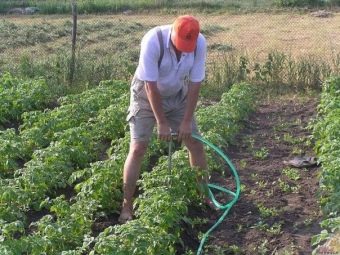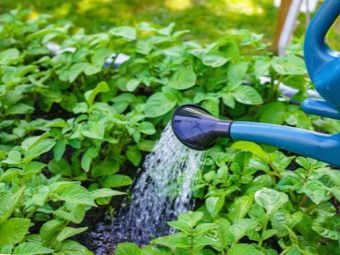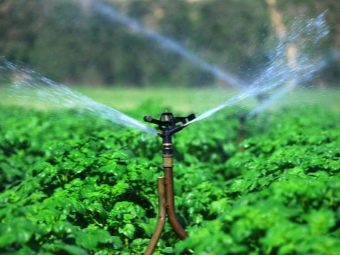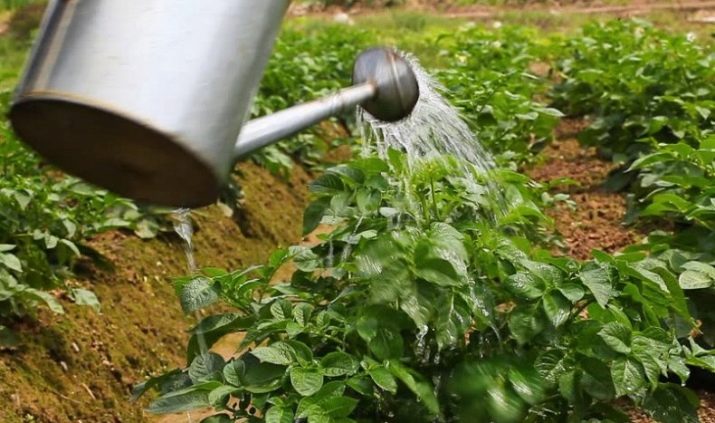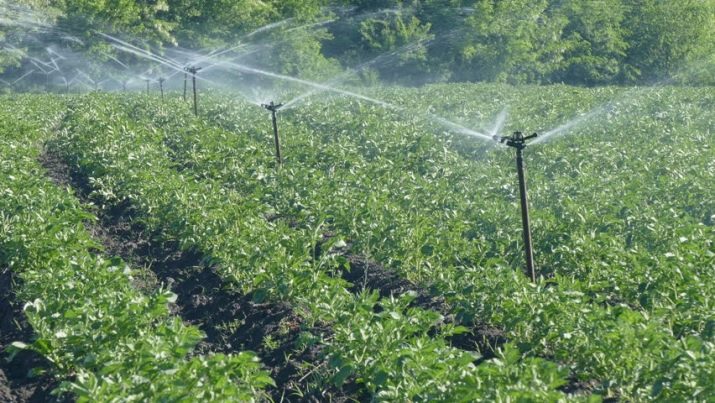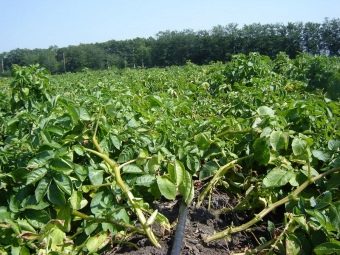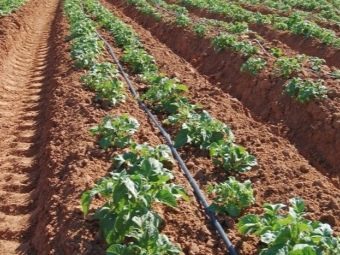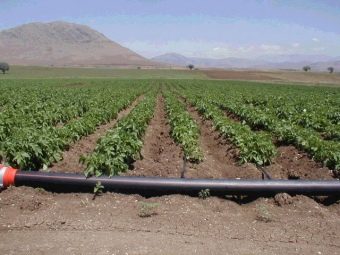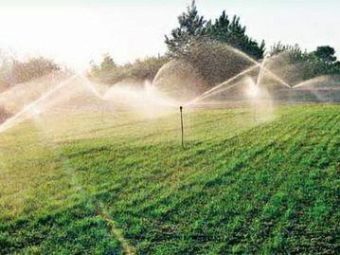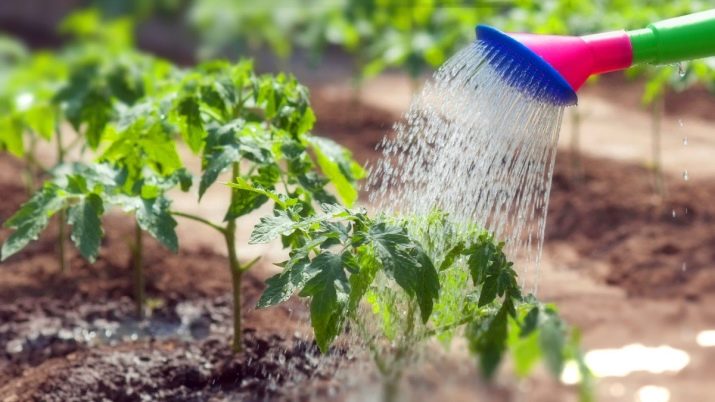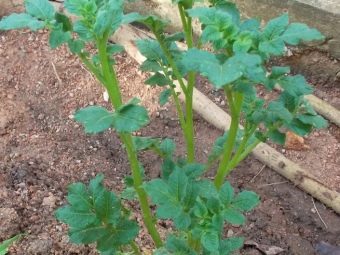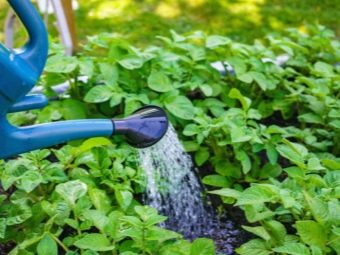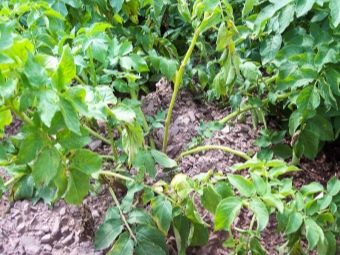Watering potatoes in open ground: features and timing
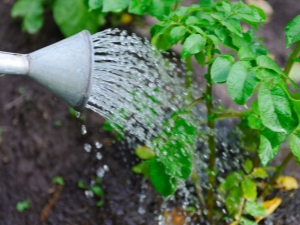
Potatoes are a rather moisture-loving plant.In a very short time, it can increase not only large green stems, but also a couple of kilograms of tubers. Therefore, it requires a large amount of nutrients that potatoes take from the top layer of the earth. Timely proper watering, as well as compliance with the rules of cultivation, are crucial in the ripening of the abundant harvest of this root.
Do I need to water the culture?
Often the owners of the beds wonder whether they need to water the potatoes in the open field, or it is raining enough to ensure a good harvest. Experienced gardeners, who devote much time to their beds, believe that they need to be watered. This is especially true in those periods when there is no rain for a long time. Some regions suffer from strong winds that deprive the earth of moisture. In this scenario, the potatoes need to be watered every 5 days.
If the plant does not receive adequate moisture in the initial stage of growth, this will affect the number of tubers under the bush. Therefore, irrigation is very important for potatoes, especially in spring. But there are those gardeners who assure that it’s not worth watering potatoes - this is simply a waste of time. They claim that they have a harvest no worse than those who regularly spend time on watering vegetables.
Differences in irrigation mode often depend on the quality of the land allotted for potatoes. If the ground is quite dense and heavy, then the humidity in it will be increased without it, especially during periods of rain. Such a plot should not be watered; in this case, the harvest will be saved by frequent weeding, which will loosen the ground and give the plant more oxygen.
In cases where the land is sandy and there was very little rain, watering should be done throughout the entire growth period of the potato. After all, the sand dries out very quickly, and without irrigation the potatoes will not give the proper harvest.
It is worth considering in more detail what watering potatoes will give at a certain time:
- when the potatoes are just starting to grow, watering ensures a good growth of the stems;
- watering potatoes during the flowering period will provide an opportunity to get a greater number of high-quality tubers;
- for the rest of the time, the hours given to watering will provide a rich harvest, and the potatoes will turn out large.
When and how often to moisturize?
Tubers with seedlings in most regions are planted in May, when the soil warms up to 10 C and contains enough moisture. Until small leaves appeared above the ground, the vegetable doesn’t really need artificial moisture. Especially if the potato was planted in a moist soil. However, when the plant starts to grow, the need for water will greatly increase. Therefore it is worthwhile to consider in more detail when and how often during the season it is necessary to water the potatoes.
The first time the hosts water the potatoes when the stems are about 10 cm above the soil. Water the plant should be right in the middle of the bush. This process should be divided into several stages. First you need to pour a small part of the water under the bush and wait a little for it to soak. Then you need to top up the rest of the liquid. This is done so that the earth is moistened evenly, and the potatoes are not flooded. If you make watering earlier, it will trigger the development of the root system above the surface.
Such plants subsequently not only experience a constant lack of moisture, but also develop poorly.
If we compare the early and late varieties of potatoes, the first ones require much less water, but they use it more intensively. Therefore, we must ensure that the soil does not dry out. To identify when to moisten the soil, you can simply lower the hand into the ground to the depth of your fingers. If the soil is dry, then it requires watering. As the plant grows, it will consume more water. The amount of liquid needed for watering one seedling can reach up to 6 liters. Since part of it evaporates into the air, in the heat each bush should receive up to 12 liters of water.
It is very important to water the land in the formation of tubers. It occurs during the flowering of potatoes. However, it is not worth waiting for the mass appearance of flowers, it is better to produce watering already at the beginning of the first buds. This will increase the yield by about 30%. The timing of the next watering associated with the growth of young tubers. This process begins after the flowering itself ends, and ends when the tops wither. Each bush should receive at least 20 liters of water - it is this amount of moisture that can wet the layer of earth.
Early potato varieties grow quickly enough, so spring watering is better suited for them. After all, the lack of water during this period can lead to a decrease in the abundance of the crop. If there is not enough time for watering, then mulching can be done that will not allow moisture to evaporate from the ground too quickly.
Ways
There are two types of irrigation: mechanical and manual irrigation. But some gardeners are also called “dry” irrigation of work on loosening and hilling this crop. After all, this process helps moisture to stay in the ground for much longer. In addition, these works saturate the plant itself with oxygen. “Dry” watering or ordinary weeding begins almost after the appearance of the first shoots.
The land between the rows is loosened after each irrigation of the land. When sprouts reach a height of 10 cm, each individual potato bush is spud. For the harvest to be rich, these processes need to be repeated three times. This must be done before the first flowers were born. Hilling needs to be done carefully so as not to injure the tubers that have already appeared. It is recommended to water potatoes early in the morning or late in the evening. The fluid is discharged through the furrows, with a hose or with the help of drip irrigation.
Mechanical
Such irrigation includes both drip irrigation and sprinkling. The first delivers water directly to the root system of the vegetable. There is a special installation for irrigating the roots. This method is necessary for those gardeners who grow large volumes of potatoes, as well as for people who can not lift weights and carry water.
Sprinkler irrigation systems are located directly above the ground or made in the form of networks that can be installed both above and below the ground. The first of them are perfect for irrigating potatoes before flowering and after it. But during the flowering itself, it is impossible to water the potatoes in any way. This leads to the fact that the pollen is washed off, and yields can drop sharply.
It is necessary to decide on how large the water drops will be. If they are too large, then the ground under the bush will become dense, and for potatoes it is bad. When using small droplets, the soil may not receive water at all, since the liquid will remain on the leaves and stems and will simply evaporate. In these cases it is necessary to loosen the ground as often as possible.
It is very convenient to use the grid. Due to this, water flows directly into the root system of the plant. In addition, this option is good because water does not compact the soil and does not form a crust on the surface. The only drawback of mechanical watering is the high cost of the plants themselves, as well as some additional equipment. Both water dispensers and timers are expensive.
Manually
This method is quite simple and familiar to almost everyone. Watering potatoes occurs with watering cans or simple hoses, which are brought to each bush separately. The advantage of manual watering is a point effect on plants. In this case, you can water only those bushes that most require it. But this option is suitable only for very small areas, because watering a large area will take too long if done manually.
You need to water gradually. At first, a liter of water is poured directly under the root, and then, when the moisture is fully absorbed, you can re-water it. One bush is saturated with moisture 4 liters of water.In general, such a process is not particularly difficult, but it will be much easier to do this with a hose. In order not to blur the ground around the bush, it is necessary to put a small spray gun on the end of the hose.
First, a certain row or square of land is watered, and then the next sector. Then you need to return to the first row and repeat the procedure. This is to ensure that the earth is well moistened.
Fundamental rules
It is important to know the following.
- Having decided to grow potatoes on your own plot, you need to familiarize yourself with the basic rules for irrigation.
- To make the irrigation of a plant better with water heated by the sun. After all, a potato is a plant of the family of the nightshade, which means that it has rather tender roots. When ice water gets on them, the rhizome gradually rots.
- It will be right to start watering when sprouts up to 10 cm in size will appear above the ground.
- When planting, potatoes must be protected from moisture overload, as part of it may simply rot. Therefore, at first, this plant is better not to water.
- Do not forget about the most important periods when irrigation is needed. First of all, it is budding plants. At this stage, each bush needs about 5 liters of water. Watering is recommended twice a week. After the flowers completely fall off, you can water the plants less often - once a week it will be enough. Gradually, reduce the amount of liquid used to 4 liters. And the last stage is watering formed tubers. At this time, the potato requires a lot of water for growth and full development, and up to 6 liters can be poured under one bush.
- It is necessary to take into account the climate and weather. In the heat, irrigation is done up to 6 times a month. When it rains, the number of waterings is reduced to three, or even less than once a month.
Signs of excess and lack of moisture
Both the lack of moisture and its excess adversely affect all phases of potato growth and the final yield. Therefore it is necessary to observe the condition of the plants with special attention.
When the plant lacks moisture, it can be determined by the following features:
- turgor of stalks and leaves decreases, they become sluggish and drooping, and also a little brighten;
- the growth of the stems stops, and the buds that have already been formed do not open;
- small undeveloped stems die off completely.
Excess moisture in the soil often leads to the attack of potatoes by various fungal diseases and root decay. All this can be defined as follows:
- leaves become drooping and slightly aquatic;
- At the bottom of the stems stains may appear, and in some cases a raid will form;
- potatoes do not grow, most tubers begin to rot.
To avoid this, you need to carefully monitor the plants. In those cases when moisture is not enough, it is necessary to irrigate the potatoes. If there is a lot of moisture, it is necessary to slightly thin the bushes so that the plant can “air out”. As can be seen from the above, potatoes need regular watering. But this mostly refers to those regions where summer does not spoil the beds with rains. If in such an area it is right to take care of plants and water them regularly, they will remain healthy and will delight gardeners with a good harvest.
You will learn more about how to water potatoes in the open field from the following video.

